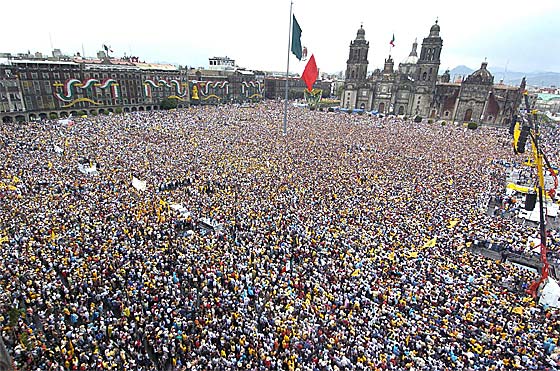 The Mexican Supreme Court has appointed a second commission this week to investigate over a thousand human rights violations in last year’s uprising in the Southern state of Oaxaca. This commission will examine armed attacks that occurred between May 2006 to January 2007 in which at least two dozen people were killed, 300 people wounded and 575 arbitrarily detained. It will act on the results of the first commission which received 1,352 justified complaints of rights violations, mainly for excessive use of force or improper treatment of suspects by local and federal police.
The Mexican Supreme Court has appointed a second commission this week to investigate over a thousand human rights violations in last year’s uprising in the Southern state of Oaxaca. This commission will examine armed attacks that occurred between May 2006 to January 2007 in which at least two dozen people were killed, 300 people wounded and 575 arbitrarily detained. It will act on the results of the first commission which received 1,352 justified complaints of rights violations, mainly for excessive use of force or improper treatment of suspects by local and federal police. The uprising started out as a strike by teachers who were later joined by hundreds of social organisations in a mass demonstration against the State’s Governor and his irregular army. Together they formed an alternative government called the Popular Assembly of the People of Oaxaca (APPO). Demonstrators hijacked and burned buses to create roadblocks and barricades and chased police out of the city. The Oaxaca uprising brought economic and tourist activity virtually to a halt for months.
Oaxaca has been the personal fiefdom of Ulises Ruiz Ortiz (also known as “URO”) since he became governor of Oaxaca in 2004. He tried to prevent the commission from being instituted and is now the subject of renewed protests. Hundreds of delegates of social movements in the state have occupied the central square of the state capital (also called Oaxaca) in a week-long vigil, and are now threatening to take more radical actions if their demands are not addressed.
Those demands include URO’s resignation and the release of dozens of activists from the first uprising who remain in jail on charges that include property damage. URO has refused to accede to any demands so far. The latest protests have not appeared to interfere with the slowly recovering tourism trade, the city's lifeblood.
The current protest resembles how the first one started. Back in May 2006, the teachers’ strike began and some of them brought their protest to the central city square which they occupied. URO refused to accede to their demands. Instead he counter-attacked. The protesters were sleeping in the square on the night of 14 June when he sent riot police to smash the protest.
They were accompanied by dogs who viciously attacked the sleeping teachers and supporters. Police tear-gassed everyone in the vicinity, including pregnant women and children; one woman miscarried as a result. Ninety-two people were wounded. Members of the community reacted with outrage, fighting back with anything they could find. They chased the police from the square, and re-established the camp. The incident became the spark for the creation of APPO, which comprised almost 350 different civil organizations working in areas of indigenous issues, sustainable community development, human rights, and social justice.
After 14 June, the protest escalated as did the body count. URO then sent heavily armed police officers dressed as civilians to attack protestors throughout the capital. Video footage identified assailants as municipal police officers and ruling party officials. No-one was charged for any crimes. Among the dead was a 36 year old US journalist and activist named Bradley Roland Will.
Brad Will was an Indymedia filmmaker from New York who was killed while filming a clash between demonstrators and gunmen. Will travelled to Mexico on a tourist visa which violated Mexican law. In October he was videotaping near a pro-strike barricade when gunmen approached shot him and two local protesters Esteban López and Emilio Fabián. Will died while he was being carried away from the area. The Committee to Protect Journalists sent an open letter to the Mexican attorney general calling on the federal government to launch an official investigation into Will's death.
Oaxaca has 3.5 million people and is Mexico’s second poorest state (just ahead of its neighbour Chiapas). According to the United Nations Development Programme (UNDP), has poverty levels similar to that of the Occupied Palestinian Territories. The state is governed by the Institutional Revolutionary Party (PRI) which ruled the country for most of the last 80 years. Mexican economic development policies have entrenched Oaxacan communities in a cycle of bare subsistence and poverty. Conditions on US bank loans and bailouts have seen drastic cuts in expenditures intended to raise rural incomes. Subsidies were slashed for necessities like electricity, bus fares, tortillas, petrol and milk.
 The protests were mostly ended in November when Police (now under Federal control) again went on the offensive, making many arrests and clearing away APPO's last encampment in the city. While the teachers that started the strike are now back at work, their complaints remain. As well as pay and conditions, education in Oaxaca students presents peculiar obstacles for schools. Many natives speak only indigenous languages such as Mixteco and Zapoteco. Schools often rely on students who speak Spanish and a Oaxacan dialect to act as translators.
The protests were mostly ended in November when Police (now under Federal control) again went on the offensive, making many arrests and clearing away APPO's last encampment in the city. While the teachers that started the strike are now back at work, their complaints remain. As well as pay and conditions, education in Oaxaca students presents peculiar obstacles for schools. Many natives speak only indigenous languages such as Mixteco and Zapoteco. Schools often rely on students who speak Spanish and a Oaxacan dialect to act as translators.
No comments:
Post a Comment